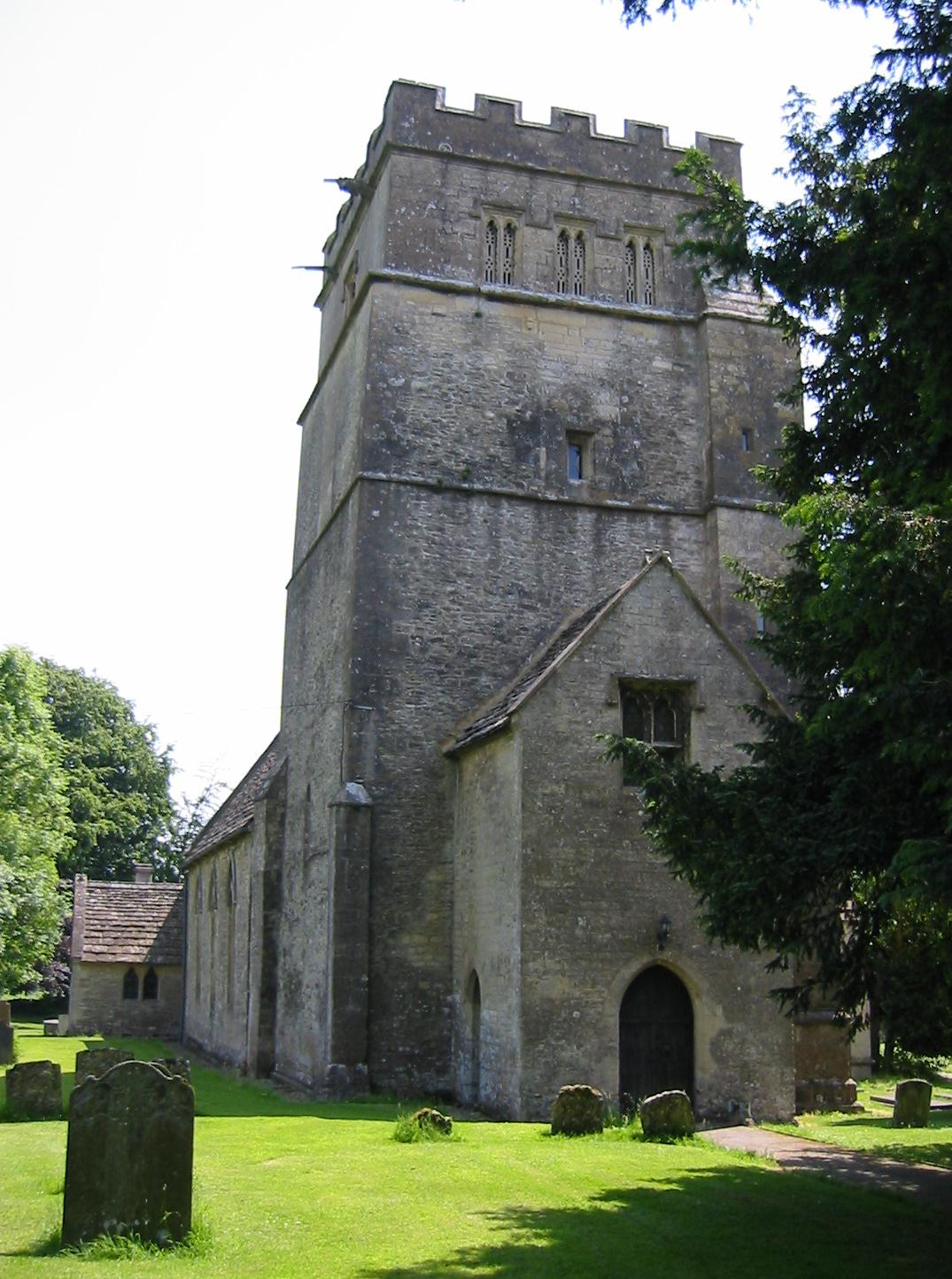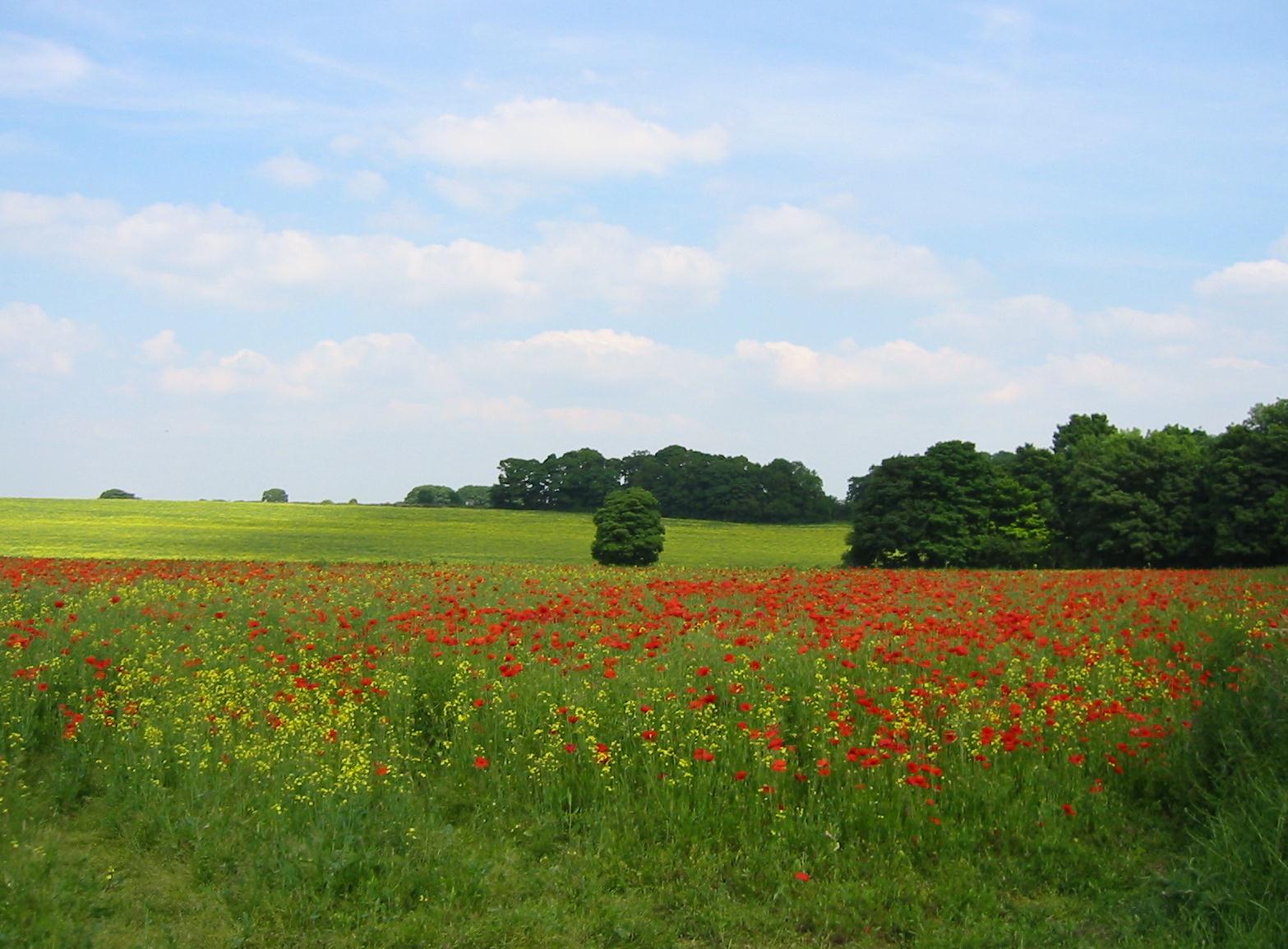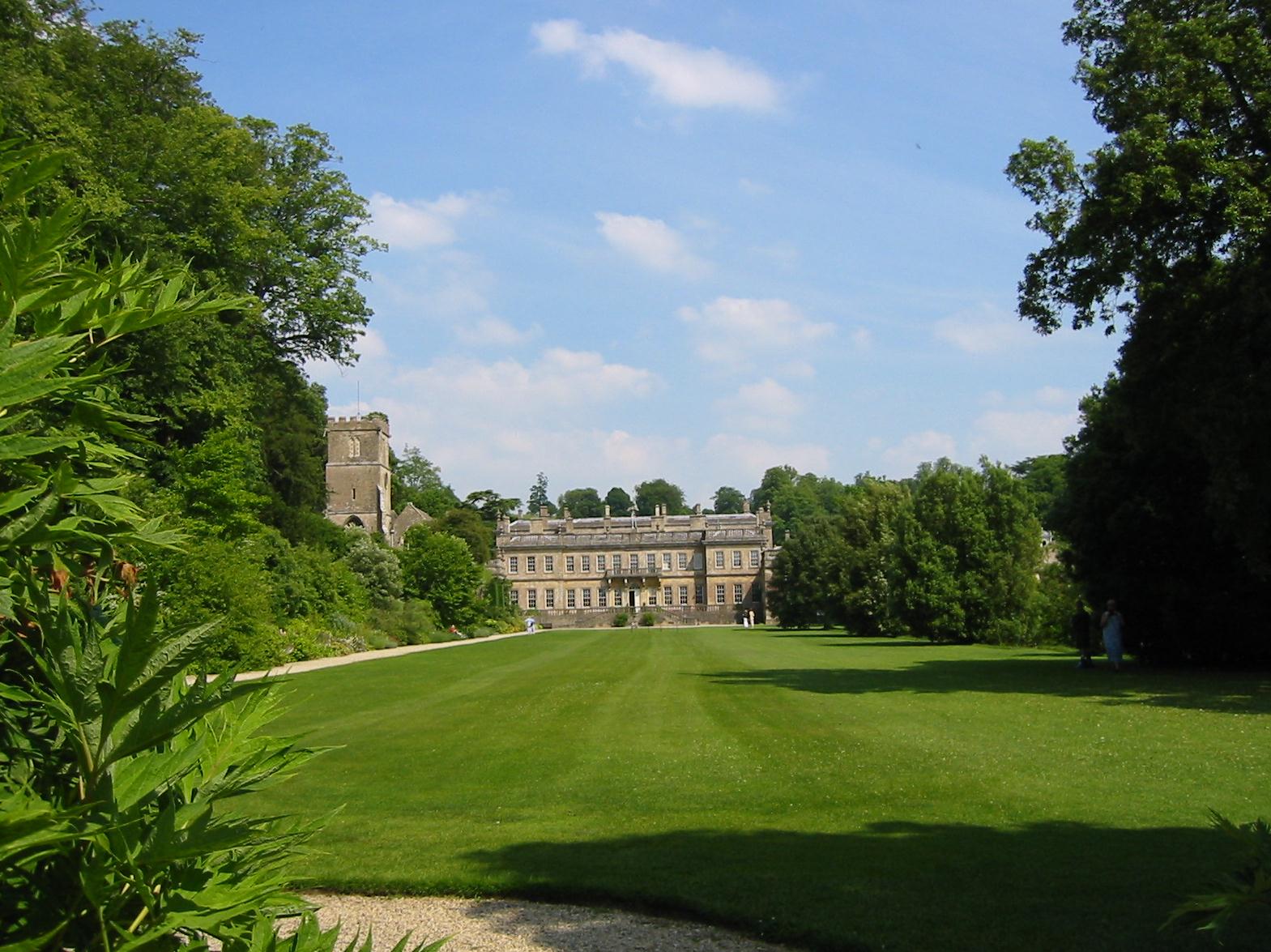June 16, 2003: Old Sodbury to Pennsylvania
I used the upstairs bathroom to shave on this morning, the fourth day of our walk – a day which began rather slowly on a sunny Monday. The beefy chaps, the ones who had been sitting next to us during quiz time, were downstairs early (one had been in residence opposite Margie’s room) and Mrs. Harris, in jeans now, was cooking their breakfast. When I mentioned that we had met this lot at the pub she told me that, in fact, they were prison guards! One of them was already in uniform; meanwhile a slow-moving Harold was still in his pajamas. Margie had borrowed a pair of scissors from our hostess and was making herself a pair of shorts on what promised to be another warm day.
In fact I wanted a late start to this short eight-mile day so that we could have lunch at the two and a half mile mark in Tormarton. Mrs. H. was quite relaxed about this and, after attending to our modest breakfast needs, she began a series of errands in her car while we slowly got our packs together and settled down to do some reading in the downstairs lounge. I was reading an article on the college admissions lottery – which I passed on to Harold. The Lees had already discovered the local newsagent. The blue van of the Compass man pulled in and the old codger, complaining of a sore foot, piled in our bags – mine always contained my trail sweatshirt; there was no point in my carrying it on my back in this heat – though I did persist in lugging my raingear.
At about 10:40 we finally hit the road, passing the Dog one last time and continuing down its side road in a southerly direction and finding our escape onto a field path, which climbed a brief hill and put us onto a tractor-filled road down to the hamlet of Coomb’s End. From here we entered the precincts of Doddington Park (the stately home was out of sight), crossing the driveway and heading steeply uphill on a grassy trod toward the borders of Frenchpiece Wood above us. I never saw any bridge that could be called “ornamental” and the promised white posts were not forthcoming either, but it was easy to keep on route as long as you kept the woodland on your left. We were in gently rolling farm country here and the last of the Cotswold escarpment was definitely behind us.
We passed through a line of trees and reached the Bath Road, out in the open sun again for passage through a variety of fields and across a series of roads as we neared Tormarton. Tosh had plucked another mystery plant and wanted every villager she encountered to identify the crop in question. A sunbather, a workman and a lady in a muumuu each failed to provide a satisfactory explanation. The rest of us stood around while the lady made her enquiries but eventually I continued on through a grassy field and into the yard of Tormarton Church. It was unlocked so we had a look around and then, as it was now 1:15, wandered into the village itself to have lunch at the Portcullis Inn.
We found a cool corner and ordered our drinks. Harold and I had cod, chips and peas again. The barman, who claimed he was a dairy farmer, suggested that Tosh’s mystery crop was linseed and she let the matter drop after that. The publican also appeared to suggest an alternative to the original route south of Tormarton but I felt it involved perhaps too much road walking and, in the end, it was not waymarked – so I decided to stick to the original plan. Outside I lathered up with sunblock and waited for the others to get their act together. An electricity van from Ireland was out front and its occupants poured over a large map; they were either lost or up to mischief. Someone had placed a miniature anvil in a front yard with “Cotswold Way” painted on it and Margie and I took pictures.
The need for an alternative route soon became evident and the next mile or so was certainly the least pleasant on the entire route. We headed south through a series of fields and found a road heading west. It was quite warm and there was nothing of interest but weeds and hurtling lorries, including the van from Ireland. When we reached the A46, opposite a decaying rotunda, we were back in motorized lunacy for sure.
Tosh was very nervous and kept asking me to explain what we would have to do to get across the gigantic M4, which was bellowing off in the distance. This required us to walk on the verge of the A46, heading south (with little evidence of a path and much litter) until we reached the roundabout just north of the motorway. We had to wait for a break in the traffic on our right in order to rush forward to a cement island from which we made a second dash onto the pavement of the highway as it bridged the M4, roaring below us.
Footing was just as uncomfortable as we continued south past a vehicle-clogged laybay (someone was selling hot food from a van) and then there was the task of crossing to the other side of the A46 (also in two stages). We were looking for an entry into a parking lot and at the bottom end of this empty space we discovered a second lot on our left. Fortunately the gate between the two was not locked so we pushed it open and the ladies used the nearby loos. The Irish van was here too.
A Cotswold Way sign (not much evidence of these in the last hour) pointed us to a woodland path and we were soon back in real countryside, again keeping trees on our left as we followed a narrow nettle-bedecked path (there seemed to be a parallel path within the woods; this would have been much more pleasant).
We rounded a corner and began a long stretch along the edge of a field that, after some confusion, we identified as oilseed rape. Yellow blossoms crushed themselves against our shorts and the footing was treacherous since the walker loses all sight on his feet on such an overgrown surface. We eventually crossed a road and continued forward toward Dyrham Park, with wonderful red-orange poppies now sharing the field on our left with the rapeseed. I took several pictures.
When we reached the wall of the park we turned right. Tosh was already agitating for another rest stop, though I disdained most of the places she suggested since they were dominated by piles of cow muck. She did stay behind for a loo stop and was in this fashion startled by the sight of a leaping fawn on the other side of the wall (there is a large deer park here). When we had continued our descent down to the cottages at the bottom we found a grassy spot directly behind the locked back gates of Dyrham Park and here we sat down for a nice rest.
It seemed a shame that there was no entrance from the west side into the grounds of this stately home, though there is a good view: here we were, National Trust members, staring across the street at tourists who had arrived no doubt via internal combustion engine – but prevented from joining them ourselves without a very long detour, involving miles of road walking. We had a snack (I finished the last of Margie’s dried apricots from Traverse City) and some liquid and then we took the road to climb back up a short way for a southerly turnoff on field paths. These gave way to a jungle surrounding some new ponds and once a heron took slowly to the air directly in front of us.
It was quite warm in the late afternoon sun and Tosh had just realized that we had a major climb up through Dyrham Wood above us. I made the mistake of saying that at least some of the ascent would be under the cover of trees and she nagged me to know when this would happen. We paused at the entrance. Was it here that Harold, reaching for his pack on the ground, slipped and bruised a rib? It was the only time that anyone fell on this trip and it was an unusual incident since he was standing still at the time.
We continue to climb up through the wood but Tosh discovered a trail register in a lock box and sat down to write some appropriate comments. The rest of us struggled back to the light at the top of the hill, another rape field, but Marge and I had reached a highway without any sight of the Lees behind us. When they at last seemed to be moving forward we crossed the road and followed a field path to the north, eventually reaching a right turn through a final field. (Later we discovered that Tosh had left her Brussels cap back at the register and had to go back down a considerable distance to retrieve it.)
We passed a few buildings on our left and reached the hamlet of Pennsylvania, making our first stop at the Shell Station, which also served as the local mini-mart and which we would use to buy our sandwiches the following day. Each of us bought a cold drink now. I asked for the opening times of this establishment for the morrow and for directions to Old Swan Cottage and this was soon discovered right behind the defunct Swan Inn on the busy A46.
Mrs Mutlow greeted us at 5:20 and so did her mutts, two Shih-Tsus (or Lhasa Apsos, I always get confused), including a female who had just lost a litter of puppies (there was a bereavement card on the mantle). We were taken upstairs to tiny rooms that at least had nice bathrooms attached, and I had a shower. We also went up to a picnic table above the cottage to have our recently purchased drinks. The Lees had the room closest to the highway and this provided a bit of a roar for much of the night. I quickly called it the Pennsylvania Turnpike.
When I had booked Mrs. Mutlow had explained that, with the demise of the Swan, guests would have to walk a further ten minutes into Cold Ashton to get to the White Hart for their evening meals. This looked like an easy enough task for us and a 7:00 we dashed across the Turnpike for another half mile on the Costwold Way. In the event this distance was quite a struggle since the path was overgrown with rape; out in front, I got the worst of it (it was often shoulder-high) and the tug on my legs really hurt my hips, which had been the subject of four visits to the physiotherapist in March.
Of course our bootlaces were undone by the time we had cleared this field and we had to retie them before climbing another hill. I noticed that my trousers (I had zipped the legs back on for the formality of the evening meal) were streaked with green. Our path leveled off and we reached a road, the lights of the White Hart in front of us. I had been considering going the long way round to this spot, which we would need to reach again tomorrow, but any idea of road walking was counterbalanced by the great speed of the vehicles that now passed us on our way to the venerable pub. Its sign said its foundations dated back to 1600; “This means that Shakespeare could have stopped at this inn,” I said, “and Falstaff most certainly did.”
The place was pretty quiet on a Monday night and we ordered our drinks from another bar lady with tattooed biceps. The cook seemed to be the only other member of staff. We had a nice leisurely meal. I had a final scampi and chips and we all finished with chocolate nut sundaes. A Japanese guy with his English family came in and there was another walker, a daffy dame who was walking the CW from south to north; she had discovered that she couldn’t rely on waymarks and an OS map alone; I told her to get a real guidebook.
On the tape deck we had a nice medley of American classics sung, surprisingly, by Rod Stewart. I asked the bar lady about this and she showed me the CD. I phoned Dorothy on the mobile and Marge phoned Mr. Mutlow, who had kindly agreed to come fetch us; it was about 9:30.
Back at old Swan Cottage I heard the Japanese man seeking accommodation – and being directed to the next village. For once there was decent bedside lighting but I had trouble keeping my eyes open, in spite of the roar of the occasional lorry, and soon fell asleep.
To continue with our next stage you need:
Day 11: Pennsylvania to Bath – 11 miles



